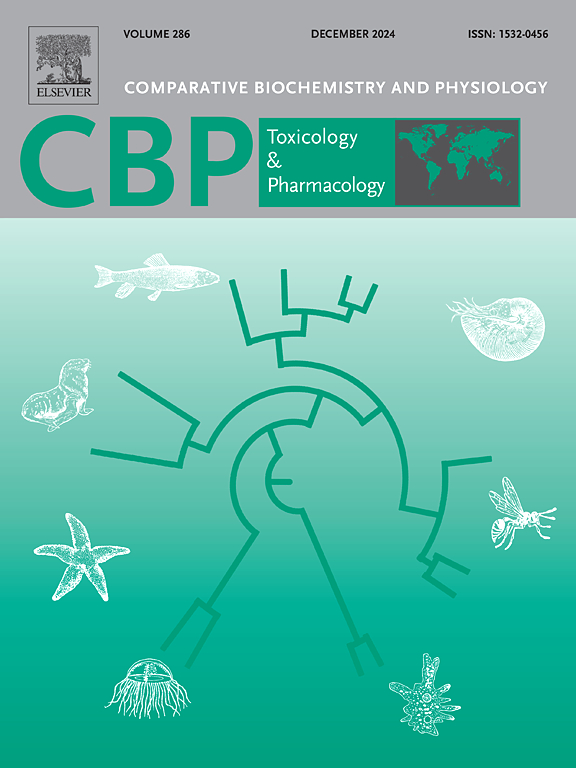Chronic chlorpyrifos exposure induces oxidative stress, neurological damage, and hepatopancreas enrichment in Chinese mitten crab (Eriocheir sinensis)
IF 3.9
3区 环境科学与生态学
Q2 BIOCHEMISTRY & MOLECULAR BIOLOGY
Comparative Biochemistry and Physiology C-toxicology & Pharmacology
Pub Date : 2024-12-15
DOI:10.1016/j.cbpc.2024.110111
引用次数: 0
Abstract
The toxic effects of long-term exposure to low doses of chlorpyrifos (CPF) on Eriocheir sinensis were evaluated using acute toxicity tests, transcriptome analyses, and metabolome profiling. Four groups (three replicates per group, 60 crabs)—control (no CPF exposure), high exposure (0.12 mg/L CPF), medium exposure (0.036 mg/L), and low exposure (0.012 mg/L)—were subjected to CPF for 21 days. Tissue damage, antioxidant enzyme activity, transcriptional changes, and metabolic alterations in E. sinensis were analyzed. The results demonstrated that CPF disrupted the regulatory networks of transcription and metabolism in crabs under the experimental concentration conditions, with the severity of effects increasing as the duration of exposure lengthened despite the crabs' efforts to activate key defense mechanisms, such as upregulation of cholinesterase 1-like gene expression, to counteract organophosphorus toxicity and adapt to CPF presence in their environment. Even at low concentrations (0.012 mg/L), neurobehavioral development and the antioxidant kinase system in crabs were impaired, leading to hepatopancreatic tissue lesions that negatively affect their growth and survival rates. Additionally, E. sinensis accumulates significant levels of CPF, which may pose food safety concerns when humans consume them. Therefore, ensuring the rational use of CPF requires maintaining appropriate water concentrations to minimize direct harm to aquatic organisms and indirect impacts on food safety associated with this pesticide.

长期接触毒死蜱会诱发中华绒螯蟹氧化应激、神经损伤和肝胰腺富集。
通过急性毒性试验、转录组分析和代谢组分析,评估了长期暴露于低剂量毒死蜱(CPF)对中华绒螯蟹的毒性作用。四组(每组3个重复,60只螃蟹)——对照组(无CPF暴露)、高暴露组(0.12 mg/L CPF)、中暴露组(0.036 mg/L)和低暴露组(0.012 mg/L)进行21 天的CPF处理。分析了中华赤霉素的组织损伤、抗氧化酶活性、转录变化和代谢变化。结果表明,在实验浓度条件下,CPF破坏了螃蟹的转录和代谢调节网络,尽管螃蟹努力激活关键的防御机制,如上调胆碱酯酶1样基因表达,以抵消有机磷毒性并适应CPF的存在,但随着暴露时间的延长,影响的程度越来越严重。即使在低浓度(0.012 mg/L)下,螃蟹的神经行为发育和抗氧化激酶系统也会受到损害,导致肝胰腺组织病变,从而对螃蟹的生长和存活率产生负面影响。此外,中华赤霉素积累了大量的CPF,当人类食用它们时可能会引起食品安全问题。因此,确保CPF的合理使用需要保持适当的水浓度,以尽量减少对水生生物的直接危害以及与该农药相关的对食品安全的间接影响。
本文章由计算机程序翻译,如有差异,请以英文原文为准。
求助全文
约1分钟内获得全文
求助全文
来源期刊
CiteScore
7.50
自引率
5.10%
发文量
206
审稿时长
30 days
期刊介绍:
Part C: Toxicology and Pharmacology. This journal is concerned with chemical and drug action at different levels of organization, biotransformation of xenobiotics, mechanisms of toxicity, including reactive oxygen species and carcinogenesis, endocrine disruptors, natural products chemistry, and signal transduction with a molecular approach to these fields.

 求助内容:
求助内容: 应助结果提醒方式:
应助结果提醒方式:


